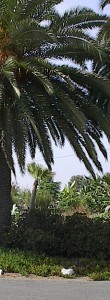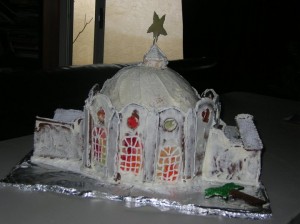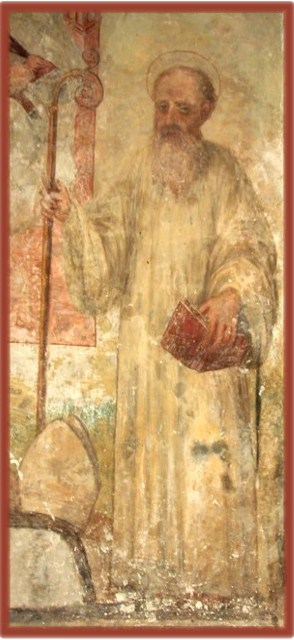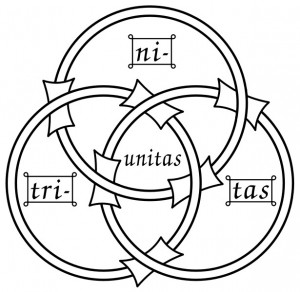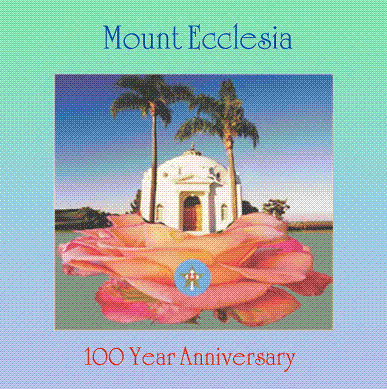The Holy Trinity
and
The Lord’s Prayer
And so it is in the very truest and most literal sense a NEW-BORN CHRIST that we hail at each approaching Yule-feast, and Christmas is the most vital annual event for all humanity, whether we realize it or not.
Max Heindel
What is meant by the Second Aspect of the Triune God?
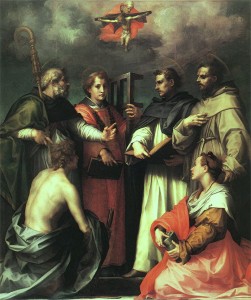
Disputation Over the Trinity - Andrea del Sarto - 1517
God is one, just as the light is one, but, as the light passing through the atmosphere is refracted into three primary colors–red, yellow and blue–so also God, when he manifests or reflects himself in nature, is threefold in his manifestation. There is first the Creative principle, next there is the Preservative principle, and in the third place there is the principle of Destruction of the forms which have been created, preserved for a time while useful, then to be destroyed in order that the material from which they were constructed may be used in the building of new forms.
These three principles of God have been called by different names in different religions, and much ink and many goose quills have been used in latter years to defend or decry the idea of a Trinity, though that ought to be manifest to anyone who will look about him in nature with a thoughtful mind. In the Western World, we have been used to calling the Second Aspect of the Triune God, the unified preserving principle, Christ; and it is very appropriate in a certain sense, because the Christ came as the teacher of Love and Universal Brotherhood which was to supersede nations that war against one another, and He Himself said that there was a still higher stage when the kingdom He was to establish should be delivered to the Father and all should be one in Him. Questions and Answers I, 150 – 151.
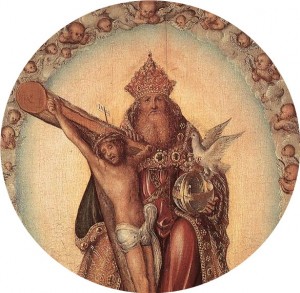
Trinity - detail - Lucas Cranach, the Elder 1515-1518
To pray to a purpose we must pray aright, and in the Lord’s Prayer we have a most wonderful pattern, for it caters to the needs of man as no other formula could do. Within a few short sentences it encompasses all the complexities of the relationship of God to man.
To properly understand this sublime prayer and to be able to render it understandingly and efficiently, let us briefly state some of the teachings given in earlier lectures.
The Father is the highest Initiate of the Saturn Period.
The Son is the highest Initiate of the Sun Period.
The Holy Spirit is the highest Initiate of the Moon Period.
The Divine Spirit and the dense body of man started their evolution in the Saturn Period and are therefore under the special care of the Father.
The Life Spirit and the vital body started their evolution in the Sun Period and are consequently the particular charges of the Son.
The Human Spirit and the desire body commenced to evolve in the Moon Period and are therefore the special wards of the Holy Spirit. The Holy Spirit is the creative energy in nature, and the sex energy is its reflection in man.
The Mind was added in the Earth Period and is not cared for by other or outside beings, but is to be subdued by man himself, without any outside assistance.
In the Lord’s Prayer there are seven prayers; or rather, there are three sets of two prayers and one single supplication. Each of the three sets has reference to the needs of one of the aspects of the threefold spirit and its counterpart in the threefold body. The opening sentence, “Our Father who art in Heaven,” is merely as the address upon an envelope. It relates the Trinity to the threefold Spirit, the three-fold body, and the mind. Each aspect of the Spirit connects with the prayer as specifically suited to its counterpart in the threefold body and addresses its guardian aspect in the Trinity.
The Human Spirit lifts itself upon wings of devotion to its parent aspects in the Holy Trinity and intones the opening incantation, Hallowed be Thy name.
The Life Spirit raises itself upon pinions of love and addresses the fount of its being, The Son: Thy Kingdom come.
The Divine Spirit soars with superior insight to the fountainhead whence it sprang at the dawn of time, The Father, and manifests its confidence in that all-embracing Intelligence in the words, Thy Will be done.
Having thus reached the Throne of Grace, the threefold Spirit in man profers its requests concerning the personality, the threefold body.
The Divine Spirit prays to The Father for its counterpart, the dense body, Give us our daily bread.
The Life Spirit prays to The Son for its counterpart, the vital body, Forgive us our trespasses as we forgive those who trespass against us.
The Human Spirit utters the supplication for the desire body in the words, Lead us not into temptation.
Then all join in a concentrated appeal concerning the mind, Deliver us from Evil.
The affix, For thine is the Kingdom, and the Power, and the Glory, forever,
are not given by Christ and are not prayers.
Looking at the foregoing explanation from the analytical standpoint, we find that there are three religious teachings to be given to man in helping him to attain to perfection. One is the Religion of The Holy Spirit, the next is the Religion of The Son, and the last is the Religion of the Father.
Under the regime of the Holy Spirit the human race was divided into nations and peoples segregated by their adherence to one group from fellowship with other nations. Each group was further cut off from the rest because of speaking another language. They were all put under certain laws and were taught to reverence The Name of their God.
One people worshiped him as Iao, another as Tao, others as Bel. Everywhere the name of this Lawgiver was holy. The method of segregation had the advantage that the Race Spirit in chief, Jehovah, could use one people to punish another who had transgressed his law, but it has the disadvantage that if fosters egotism and separates humanity in a manner detrimental to universal good.
It is an axiomatic truth that what does not benefit all cannot really benefit any. Therefore ways and means must be found to reunite the scattered nations and weld them into one universal Brotherhood. That is to be the work of the Religion of the Son–Christianity. The warring of nations is fostered by the Race Spirit, but the Christian Religion will eventually unite them, cause them to beat their swords into ploughshares and bring peace and good will on Earth when the Kingdom of the Son has superseded the tribes and races.
Then a still higher religious teaching, the religion of the Father, is to unite
mankind still closer. In the Kingdom of the Son there will be a Universal
Brotherhood of separate individuals having varying interests, but ready
to give and take through love, sinking individual preferences for the common
good, but when the religion of the Father becomes a fact in life, the self will
be entirely submerged in a common purpose, a single will. The Will of God
will then be done on earth as it is in heaven, where there is neither me nor
thee, but where God is All and in All. Rosicrucian Christianity Lectures, 301 –
303.
THE NEWBORN CHRIST
It has often been said in our literature that the sacrifice of Christ was not an event which took place on Golgotha, and was accomplished in a few hours once and for all time, but that the mystic births and deaths of the redeemer are continuous cosmic occurrences. We may therefore conclude that this sacrifice is necessary for our physical and spiritual evolution during the present phase of our development. As the annual birth of the Christ Child is
now approaching, it presents again a never old, ever new theme for meditation from which we may profit by pondering it with a prayer that it may create in our hearts a new light to guide us upon the path of regeneration.
The apostle gave us a wonderful definition of Deity when he said that “God is Light,” and therefore “light” has been used to illustrate the nature of the Divine in the Rosicrucian teachings, especially the mystery of the Trinity in Unity. It is clearly taught in the Holy Scriptures of all times that God is one and indivisible.
At the same time we find that as the one white light is refracted into three
primary colors, red, yellow, and blue, so God appears in a threefold role
during manifestation by the exercise of the three divine functions of Creation, Preservation, and Dissolution.
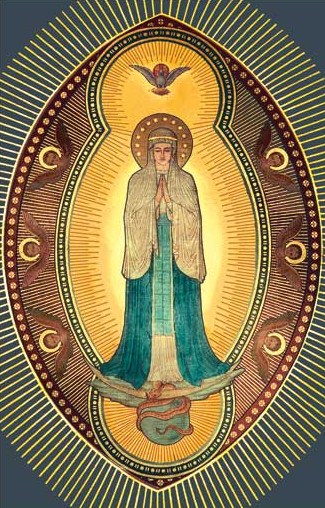
Immaculate Conception - The Beuronese Murals
When He exercises the attribute of Creation,God appears as Jehovah, the Holy Spirit; He is then Lord of law and generation and projects the solar fertility indirectly through the lunar satellites of all planets where it is necessary to furnish bodies for the evolving beings.
When He exercises the attribute of Preservation for the purpose of sustaining the bodies generated by Jehovah under the laws of nature, God appears as the Redeemer, Christ, and radiates the principles of love and regeneration directly into any planet where the creatures of Jehovah require this help to extricate themselves from the meshes of mortality and egoism in order to attain to altruism and endless life.
When God exercises the divine attitude of Dissolution, He appears as the Father who calls us back to our heavenly home to assimilate the fruits of experience and soul growth garnered by us during the day of manifestation. This Universal Solvent, the ray of the Father, then emanates from the invisible Spiritual Sun.

The Resurrection - William Blake
These divine processes of creation and birth, preservation and life, and dissolution, death, and return to the Author of our being we see everywhere about us, and we recognize the fact that they are activities of the Triune God in manifestation. But have we ever realized that in the spiritual world there are no definite events, no static conditions; that the beginning and the end of all adventures of all ages are present in the eternal “here” and “now”? From the bosom of the Father there is an everlasting out-welling of the seed of things and events which enters the realm of “time” and “space.” There it gradually crystallizes and becomes inert, necessitating dissolution that there may be room for other things and other events.
There is no escape from this cosmic law; it applies to everything in the realm of “time” and “space,” the Christ-ray included. As the lake which empties itself into the ocean is replenished when the water that left it has been evaporated, and returns to it as rain to flow again ceaselessly toward the sea, so the Spirit of Love is eternally born of the Father, day by day, hour by hour, endlessly flowing into the solar universe to redeem us from the world of matter which enmeshes us in its death grip. Wave upon wave is thus impelled outward from the sun to all the planets giving a rhythmic urge to the evolving creatures there.
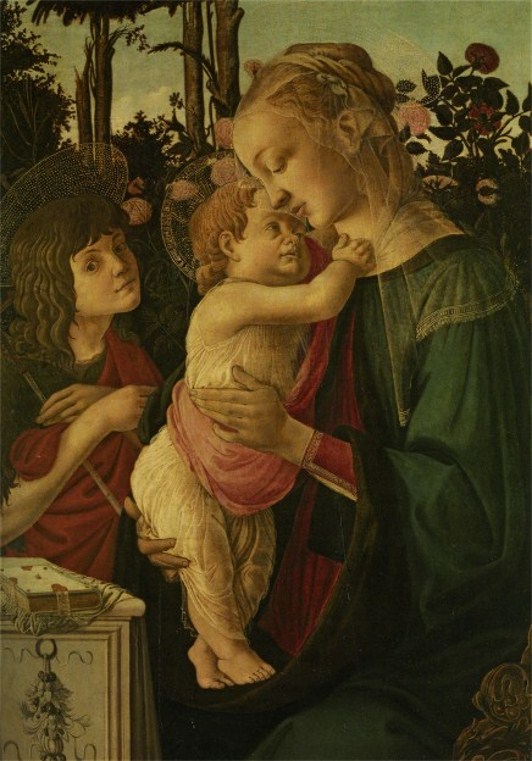
Madonna & Child with John the Baptist - Botticelli
And so it is in the very truest and most literal sense a NEW-BORN CHRIST that we hail at each approaching Yule-feast, and Christmas is the most vital annual event for all humanity, whether we realize it or not. It is not merely a commemoration of the birth of our beloved Elder Brother, Jesus, but the advent of the rejuvenating love-life of our Heavenly Father, sent by Him to redeem the world from the wintry death grip.
Without this new infusion of divine life and energy we must soon perish
physically, and our orderly progress would be frustrated so far as our present
lines of development are concerned. The Mystical
Interpretation of Christmas, 41 – 43.
Our Father, who art in heaven,
Hallowed be thy Name.
Thy Kingdom come.
Thy will be done on earth,
As it is in heaven.
Give us this day our daily bread.
And forgive us our trespasses,
As we forgive those who trespass against us.
And lead us not into temptation,
But deliver us from evil.
For thine is the kingdom, and the power and the glory
forever. Amen
Tags: Holy Spirit, Holy Trinity, immaculaate conception, Lord's Prayer







